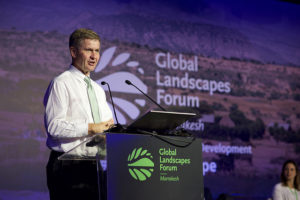 By Leona Liu, originally posted at CIFOR’s Forests News
By Leona Liu, originally posted at CIFOR’s Forests News
At the 2016 Global Landscapes Forum (GLF) in Marrakesh, held on the sidelines of COP22, Erik Solheim, Executive Director of the United Nations Environment Programme (UNEP), spoke to the Center for International Forestry Research (CIFOR) about embracing the landscape approach.
UNEP hosted a discussion forum on Unlocking private finance in forests, sustainable land use and restoration at the event, which addressed the current finance gap i.e. the fact that the demand for capital to restore landscapes is bigger than the supply, and asked how new products and mechanisms can help leverage public funding with private finance.
“The most exciting development at COP22 is the new role of business,” said Solheim. “The transformation of climate from being seen as a cost to an enormous opportunity for new green jobs and business profits is so hopeful.”
Hear more from Solheim in the video below:
First of all, landscapes mean beauty. There are so many fantastic beautiful landscapes all over the planet. In political terms, to me, it means the big picture. Not just focusing on agriculture or on the forests, just on biodiversity, or just on climate, but you take all this into one discussion so that you can ‘kill two birds with one stone.’
What does the Global Landscapes Forum provide as a platform or audience?
An enormous opportunity to resolve these problems. How can we protect the forests of the world, which are fantastically beautiful and home to orangutans and gorillas in Africa? And protect biodiversity, which is enormous and critical for climate?
You can only do that if the farmers also see the opportunity for themselves to prosper. The landscape focus is a way of bringing together the two biggest issues of our time: How to rapidly develop and bring people out of poverty, but at the same time protect the beauty of the planet.
What have you observed at COP22 that shows signs of progress following COP21?
The most exciting thing is the new role of business because up until recently, business always thought climate was costly. It was about pushing the bill to others. Now we see this as an enormous opportunity to create new jobs.
With solar prices coming down, we can invest largely in renewable energy. We have the biggest solar plant anywhere in the world right here in Morocco. Also, you see mass transit systems, new metros every year, that the Chinese are building in Shanghai and Beijing and many other cities. You see tourism which can benefit from the beauty of the elephants, gorillas or the orangutans that can both be environmentally friendly and can provide millions of jobs globally.
The transformation of climate from being seen as a cost to an enormous opportunity for new green jobs and business profits is so hopeful.











